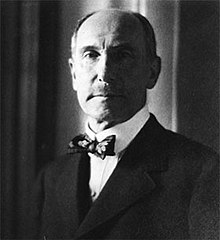Charles Lang Freer
| Charles Lang Freer | |
|---|---|

1916 photograph portrait by Edward Steichen.
|
|
| Born |
February 25, 1854 Kingston, New York, United States |
| Died | September 25, 1919 (aged 65) New York City, New York, United States |
| Resting place | Wiltwyck Cemetery 41°55′24.4″N 74°00′21.2″W / 41.923444°N 74.005889°W |
| Residence |
Charles Lang Freer House Detroit, Michigan, United States |
| Occupation | Businessman |
| Known for | Collector of Asian and American art. |
Charles Lang Freer (February 25, 1854 – September 25, 1919) was an American industrialist and art collector, best known for his large collection of Asian and American Art which he donated to the Smithsonian Institution in 1906. In addition to this 2,250-object collection, including James McNeill Whistler’s Peacock Room, Freer also founded and funded the construction of the Freer Gallery of Art in Washington, D.C. to house his collection.
Freer was born in Kingston, New York, in 1854 or 1856. As a teen, rather than finish high school, he went to work as a business clerk for a business. There, he was noticed by Frank J. Hecker, the manager of a local railroad, who hired Freer as a bookkeeper. In the 1870s, a group of investors from Detroit decided to build a rail line in Logansport, Indiana; they hired Hecker to manage the project. Hecker brought the younger Freer along.
Although the project was eventually merged out of existence, the investors were happy with Hecker and Freer, and invited the two to Detroit. In 1885, using their own capital and that of investors, Hecker and Freer formed the Peninsular Car Company to build rail cars. The investment made both wealthy, as Peninsular became Detroit's second largest car manufacturer, merging to become the Michigan-Peninsular Car Company in 1892. At the time, Michigan-Peninsular Car was Michigan's largest manufacturer. It merged again into American Car and Foundry in 1899.
In the later part of the 19th century, Freer was diagnosed with neurasthenia, the treatment for which was to concentrate on less stressful activities than business. Freer chose to begin an art collection, and by 1886 began collecting American masters, including a number of impressionist painters.
...
Wikipedia
